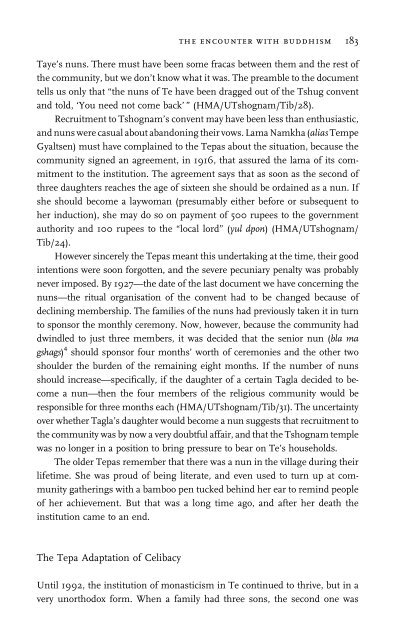Navel of the Demoness : Tibetan Buddhism and Civil Religion in ...
Navel of the Demoness : Tibetan Buddhism and Civil Religion in ...
Navel of the Demoness : Tibetan Buddhism and Civil Religion in ...
You also want an ePaper? Increase the reach of your titles
YUMPU automatically turns print PDFs into web optimized ePapers that Google loves.
86 <strong>the</strong> navel <strong>of</strong> <strong>the</strong> demoness<br />
If we reexam<strong>in</strong>e <strong>the</strong> matter ...as K<strong>in</strong>g Songtsen Gampo says, ‘‘Those<br />
who are drawn to wickedness are more numerous than those who<br />
are drawn to good; well-born people do noble deeds; for <strong>the</strong> crimes<br />
we have committed we lay <strong>the</strong> blame on o<strong>the</strong>rs; for fear that we<br />
ourselves might go hungry we turn our fa<strong>the</strong>rs out.’’ So he says,<br />
<strong>and</strong> leaders such as you must also th<strong>in</strong>k this. (pt. 2, ll. 51–57)<br />
The quotation—whose provenance I have not been able to identify—is as<br />
damn<strong>in</strong>g an assessment as might be found <strong>of</strong> <strong>the</strong> vulnerability <strong>of</strong> <strong>the</strong> Shöyul’s<br />
fragile alliance to <strong>the</strong> self-<strong>in</strong>terested action <strong>of</strong> its members. ‘‘They are all,’’ we<br />
are later assured, ‘‘wicked deceivers.’’<br />
In spite <strong>of</strong> <strong>the</strong>ir various hardships, however, <strong>the</strong> Tepas eventually ga<strong>in</strong>ed<br />
<strong>the</strong> upper h<strong>and</strong>. Whatever may have been <strong>the</strong> historical outcome <strong>of</strong> <strong>the</strong>se hostilities,<br />
<strong>the</strong> Compla<strong>in</strong>t gives Te <strong>the</strong> f<strong>in</strong>al credit for <strong>the</strong> humbl<strong>in</strong>g <strong>of</strong> Tshug:<br />
The Tshugwas, like poisonous snakes, have harmed all <strong>the</strong> lords <strong>and</strong><br />
servants <strong>of</strong> Serib; <strong>the</strong> Tepas, like <strong>the</strong> great khyung <strong>in</strong> <strong>the</strong> sky, have<br />
destroyed <strong>the</strong> poisonous snake at a stroke. (pt. 2, ll. 87–90)<br />
This is <strong>the</strong> third occasion—if we exclude <strong>the</strong> reference to <strong>the</strong> Tepas’ tak<strong>in</strong>g<br />
refuge <strong>in</strong> ‘‘<strong>the</strong> Cliff Caves <strong>of</strong> <strong>the</strong> Birds’’—on which <strong>the</strong> Tepas are explicitly<br />
assimilated to vultures or <strong>the</strong> mythical eagle called khyung. In this case, <strong>the</strong><br />
image <strong>of</strong> <strong>the</strong> khyung is developed more powerfully to accord with <strong>the</strong> mythology<br />
<strong>and</strong> iconography <strong>of</strong> this creature by chang<strong>in</strong>g <strong>the</strong> Tshugwas from sparrows<br />
(which are contrasted with vultures) to snakes, which khyung characteristically<br />
kill <strong>and</strong> devour.<br />
The Ngolak Pasture Dispute with Gelung<br />
The period covered by <strong>the</strong> Compla<strong>in</strong>t may have represented an uncommonly<br />
low po<strong>in</strong>t <strong>in</strong> Te’s relations with its neighbours—particularly Tshug—but<br />
conflicts with <strong>the</strong> surround<strong>in</strong>g communities cont<strong>in</strong>ued to arise from time to<br />
time. The two commonest causes <strong>of</strong> disputes between neighbour<strong>in</strong>g villages<br />
<strong>in</strong> Mustang are on <strong>the</strong> one h<strong>and</strong> shared irrigation sources <strong>and</strong> on <strong>the</strong> o<strong>the</strong>r<br />
usufruct <strong>of</strong> pastures. S<strong>in</strong>ce <strong>the</strong> water for Te’s fields is drawn from sources that<br />
are not used or claimed by any o<strong>the</strong>r settlements, it has been spared this<br />
problem (unlike, say, Gyaga <strong>and</strong> Tsele, whose common stream has been a<br />
cause <strong>of</strong> recurrent <strong>and</strong> sometimes violent argument). Claims to pasturel<strong>and</strong>,<br />
by contrast, have not always been undisputed. The territory <strong>of</strong> Te, as we have<br />
seen, adjo<strong>in</strong>s that <strong>of</strong> six o<strong>the</strong>r communities <strong>in</strong> Mustang: Dzong, Putra, Taye,


